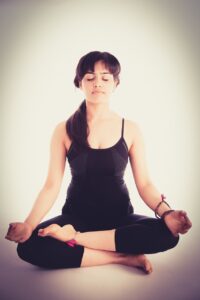
The Role of Breathing Techniques in Yoga
In yoga, breathing is more than just taking in air—it’s the key that connects your body and mind. This special way of breathing is called pranayama, which means controlling your breath to manage your energy, or prana.
While yoga poses (called asanas) help make your body stronger and more flexible, breathing techniques add calmness, focus, and energy to your practice. Whether you’re new to yoga or have been doing it for years, learning how to breathe the right way can improve your health, reduce stress, and bring peace to your daily life.
What is Yogic Breathing (Pranayama)?
Yogic breathing, or pranayama, is the conscious control and regulation of the breath. It comes from the Sanskrit words:
-
Prana = life force or vital energy
-
Ayama = expansion or control
Thus, pranayama means controlling the flow of life energy through breath.
Unlike ordinary unconscious breathing, yogic breathing is slow, deep, and rhythmic. It often involves various techniques to inhale, hold, and exhale in specific sequences, thereby influencing the nervous system, mind, and internal organs.
Benefits of Yogic Breathing
🧘♀️ Physical Health Benefits
-
Improves Lung Function: Deep breathing enhances oxygen intake and improves lung capacity.
-
Boosts Immunity: Regular practice strengthens the immune system by oxygenating cells and reducing stress hormones.
-
Balances Blood Pressure: Calms the cardiovascular system and supports heart health.
-
Enhances Digestion: Stimulates abdominal organs and promotes smoother digestion.
-
Detoxifies the Body: Increased oxygen flow helps eliminate toxins through improved circulation.
🧠 Mental & Emotional Health Benefits
-
Reduces Stress and Anxiety: Yogic breathing activates the parasympathetic nervous system, lowering cortisol levels.
-
Improves Focus and Clarity: Breath control sharpens mental alertness and clears brain fog.
-
Promotes Emotional Balance: Helps regulate mood swings and promotes emotional resilience.
-
Supports Better Sleep: Slows the mind and prepares the body for rest.
-
Increases Mindfulness: Brings awareness to the present moment, reducing reactivity and overthinking.
Popular Yogic Breathing Techniques (Pranayama)
Each pranayama technique serves a different purpose and energy effect. Here are the most widely practiced yogic breathing methods:
🌬️ 1. Nadi Shodhana (Alternate Nostril Breathing)
What it is: A calming practice that involves breathing through one nostril at a time in a structured pattern.
How to practice:
-
Sit comfortably with a straight spine.
-
Use the right thumb to close the right nostril; inhale through the left.
-
Close the left nostril with your ring finger; exhale through the right.
-
Continue alternating for 5–10 minutes.
Benefits:
-
Balances the left and right brain hemispheres
-
Reduces anxiety and promotes mental clarity
-
Enhances lung capacity and respiratory strength
🔥 2. Kapalabhati (Skull-Shining Breath)
What it is: A powerful cleansing breath that involves forceful exhalations and passive inhalations.
How to practice:
-
Sit in a meditative posture.
-
Take a deep breath in.
-
Forcefully exhale through the nose while contracting the abdomen; let inhalation happen naturally.
-
Repeat for 30–60 rounds in short bursts.
Benefits:
-
Energizes the body and mind
-
Detoxifies the lungs and abdominal organs
-
Boosts metabolism and digestion
🌪️ 3. Bhastrika (Bellows Breath)
What it is: Intense inhalation and exhalation at an equal pace, mimicking the action of bellows.
How to practice:
-
Sit upright and inhale deeply through the nose.
-
Exhale forcefully through the nose.
-
Keep the rhythm strong and fast.
-
Practice for 1–2 minutes and gradually increase.
Benefits:
-
Increases energy and vitality
-
Clears nasal passages and sinus congestion
-
Enhances oxygen delivery to tissues
🌊 4. Ujjayi (Victorious Breath or Ocean Breath)
What it is: A slow, deep breath with a slight constriction at the throat, creating a soft hissing sound.
How to practice:
-
Inhale deeply through the nose with the throat slightly tightened.
-
Exhale the same way, producing a gentle “ocean wave” sound.
-
Keep the breath long and controlled.
Benefits:
-
Promotes deep relaxation and meditative focus
-
Balances body temperature and calms the nerves
-
Improves concentration and awareness
🧊 5. Sheetali (Cooling Breath)
What it is: A breath that cools the body, great for summer or after intense exercise.
How to practice:
-
Sit in a relaxed posture.
-
Roll the tongue into a tube (or use the teeth if unable).
-
Inhale through the rolled tongue or teeth with a hissing sound.
-
Close the mouth and exhale through the nose.
Benefits:
-
Lowers body heat
-
Calms thirst and hunger cravings
-
Soothes high blood pressure and anxiety
Integrating Yogic Breathing into Daily Life
You don’t need a full yoga class to benefit from pranayama. Just a few minutes a day can have a powerful effect. Here’s a simple daily breathing routine to start:
🕯️ Morning (5–10 minutes)
-
1 minute of deep abdominal breathing
-
3 minutes of Kapalabhati
-
5 rounds of Nadi Shodhana
Result: Energizes your body, clears the mind, and sets a calm tone for the day.
🧘 Midday Reset (5 minutes)
-
Ujjayi breathing or Bhastrika (depending on your energy level)
Result: Recharges focus and relieves midday stress or fatigue.
🌙 Evening Unwind (5–10 minutes)
-
5 rounds of Nadi Shodhana
-
1–2 minutes of Sheetali or gentle Ujjayi
-
End with a short meditation or gratitude reflection
Result: Relaxes the nervous system and prepares the mind for deep sleep.
Conclusion: Breathe with Awareness, Live with Purpose
Breath is our constant companion from birth to death—yet we often take it for granted. Yogic breathing is an ancient gift, reminding us that conscious breathing holds the key to vitality, peace, and inner balance.
By incorporating pranayama techniques into your yoga practice and daily life, you’ll unlock a profound source of healing and transformation. Whether it’s calming the chaos of your mind or improving the health of your body, each mindful breath is a step closer to harmony.
